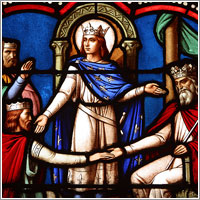 An honorific is a term used to convey esteem or respect. "Honorific" may refer broadly to the style of language or particular words used, or, as in this article, to specific words used to convey honor to one perceived as a social superior. Sometimes the term is used not quite correctly to refer to a title of honour (honorary title).
An honorific is a term used to convey esteem or respect. "Honorific" may refer broadly to the style of language or particular words used, or, as in this article, to specific words used to convey honor to one perceived as a social superior. Sometimes the term is used not quite correctly to refer to a title of honour (honorary title).
Honorifics are usually placed immediately before or after the name of the subject. They may also be used to denote occupation, such as "Doctor", "Father" (for a priest), or "Professor". Some honorifics can act as complete replacements for a name, as in "sir" or "ma'am". Subordinates will often use honorifics as punctuation before asking a superior a question or after responding to an order, "Yes, sir".
English honorifics are usually limited to formal situations.
Japanese honorifics are similar to English titles like "Mister" and "Miss," but in Japanese, which has many honorifics, their use is mandatory in many formal and informal social situations.
Korean honorifics vary according to social distinction. The Korean language also distinguishes social differences with special noun and verb endings.
In Ancient Rome honorifics like Caesar and Augustus turned into titles over time, see also: Template:Roman government.
Use of courtesy titles and honorifics in professional writing
The use of courtesy titles (Mr., Mrs., Miss, Ms.) and honorifics/styles (HRH, His Holiness, etc.) differs greatly among publications in both journalism and academia. The differences are based on tradition, practical concerns (such as space), and cultural norms. There is a continuum among publications between using no honorifics at all, using some honorifics but not styles, and using all honorifics, including styles. In certain cases honorifics and styles may be used according to some other pattern, or selectively only for certain persons.
Titles, honorifics, and styles
Only some titles are honorifics. For example, it is customary to address people holding those positions as Alderman, Chairperson, or General Secretary; but these titles are not honorific. Other titles, such as Ma'am, Doctor, or Lord — and sometimes also Ms. or Professor—are both titles and honorifics. As a rough guide, an honorific can often stand alone or be prefixed to another title (such as Mr. Mayor, Madam President, or Rabbi) as terms of address, without an attached surname.
A certain class of honorifics are known as styles. Styles are generally accompanied by a pronoun or article, pertain to holders of royal, religious, or political positions, and contain a descriptive term. The description attached within a style is of an attribute the holder of the style is purported to have. For example, "the Right Honorable John Smith" or "His Holiness Pope John XXVI." Styles are generally not thought of as titles.
Comparison of publications
Wire services
- Associated Press: The AP does not use courtesy titles except in obituaries, direct quotations, or when a story on a family may cause confusion without the use of courtesy titles. Instead, using the first and last names on first reference and the last name on later references is preferred. The AP Stylebook advises that the first reference to a member of the clergy should include a capitalized title: The Reverend John Smith on first reference and Smith or the reverend on every reference thereafter. For popes, the AP advises Pope John XXVI on first reference and John XXVI, Pope John, the pope, or the pontiff on later references. For titles of nobility, the stylebook notes that "references to members of the notability in nations that have a system of rank present special problems because nobles frequently are known by their titles rather than their given names. Their titles, in effect, become their names." In general, AP prefers to follow their general guidelines, but uses the titles "Lord," "Lady," and "Dame." AP never uses styles except in direct quotes.
- United Press International:
- Reuters:
Newspapers
- The New York Times: Stylistic concerns are governed by The New York Times Manual of Style and Usage. Unlike most newspapers, the Times uses courtesy titles in news stories (but not in editorials or "light" stories, such as lifestyle or fashion): John Smith on first reference, Mr. Smith on later references). This applies even when the person holds a non-courtesy title: Mayor John Smith on first reference, Mr. Smith or the mayor on the second. The Times never uses styles except in direct quotes. For royalty, Queen Elizabeth is acceptable on first reference to Queen Elizabeth II, with the queen or Elizabeth II used on later references.
- The Wall Street Journal:
- The Times:
- The Guardian:
- The Los Angeles Times:
- The Globe and Mail:
- USA Today:
Magazines
- Newsweek:
- Time:
- U.S. News & World Report:
- The Economist:
Reference works
- Encarta:
- Encyclopadia Britannica:
- Chicago Manual of Style:
- Bartletts's Familiar Quotations: Inconsistent usage. "George Noel Gordon, Lord Byron"; "Sir Thomas More"; "Elizabeth I"; "Francis Bacon" (not "Sir"). Most honorifics not used, and styles never.